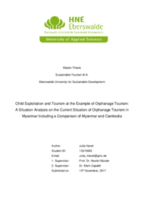Abstract
While in industrial countries most of the residential care institutions for children are replaced by alternative child care the number of orphanages increased at tourist hotspots in developing countries. The reason for this is the booming orphanage tourism. In some countries as Cambodia this type of tourist activity already turned into a huge business (Horton, 2011). Tourists and Volunteers want to do something good and many of them decide to do this by visiting, donating and working at orphanages. But instead of doing something good they support a corrupt business which exploits children. The children have to suffer under family separations, mental and physical neglect, labour and sexual exploitation. (Better Care Network, 2017; Tourism Concern, n.d.a.; Carmichael, 2011). While the business already established in some countries other countries are still unaware of it. Myanmar is one of these countries. Due to widespread poverty and a young tourism industry the concerns grew that Myanmar could turn into a second Cambodia with an increasing orphanage tourism business (Asian Development Bank, 2017b; UNICEF, 2012). Currently nearly no data exists on the current situation of orphanage tourism in Myanmar. Therefore, this thesis focused on the two questions ‘What is the current situation on orphanage tourism in Myanmar?’ and ‘What are the causes of orphanage tourism?’.
A literature research was undertaken to understand what child protection, child abuse and exploitation and residential care institution mean. Afterwards the phenomenon orphanage tourism was analysed by using Cambodia as a case study and creating a problem tree to identify the causes who lead to the phenomenon. Poverty, missing laws, unawareness on the risks of orphanage tourism, corruption and missing monitoring mechanism were the main causes. Finally a field research was undertaken in Myanmar. 48 in-depth interviews with principals form residential care institutions were conducted at the four tourism destinations Yangon, Bagan, Mandalay and Inle Region. After the field research the findings were compared with the causes from the problem tree to evaluate the current situation of orphanage tourism in Myanmar. As a result it can be said that orphanage tourism has yet not developed into a widespread business but some of the interviewed places already welcome tourists as well as foreign visitors. An understanding of the terms orphanage tourism or child protection hardly exists. Further research, for example in form of surveys on the tourists behaviour, is needed to gain more information on the current situation as well as the implementation of awareness raising measures for residential care institutions, tourists and volunteers, the government of Myanmar and the tourism industry. If these actions taken place soon the establishing of an orphanage tourism business can be avoided to protect the children of Myanmar.

